Global shutter CMOS image sensors are increasingly common in the machine vision world as their optical performance is equal to that of CCD sensors and rolling shutter sensors and while the replacement of CCD and rolling shutter sensors with global shutter CMOS sensors tends to be in the lower resolution market there is also a shift towards them in the high end market, leading to less complex camera designs and operation, while increasing the frame rates and introduce global shutter.
The current CMV product family from ams, uses the company’s patented 8T pixel design with true Correlated Double Sampling (CDS) and pipelined global shutter, and offers a wide range of resolutions from VGA up to 20Mp. A new device, the CMV50000, is a 47.5Mp image sensor capable of running at up to 30fps at full resolution in a 35mm optical format (36.43 × 27.62mm).
It has a 7920 × 6004 pixel array using a 4.6µm 8T pipelined global shutter pixel with true CDS. The sensor is designed in a way that even with a smaller pixel size, similar and better performance is achieved. The sensor is equipped with a 12b ADC, has a very low noise level (8.8e) and a high linear full well capacity (14500e) resulting in a dynamic range of 64dB. The dark current is low (66e/s at 60°C) and this together with the on-chip optical black clamping, enables the use of long exposure times of several seconds, even without cooling.
The sensor also has on-chip row correction, resulting in a clean image directly coming out of the sensor. Binning can also be enabled increasing the FWC to ~58ke and so doubling the SNR to see more detail in bright images.
The CMV50000 has an interleaved exposure HDR mode, up to 10 Regions of Interest (ROI), an accurate on-chip temperature sensor, several trigger modes and up to x4 analog gain, all controlled via simple SPI registers. All this at 30fps at full resolution, or faster with a smaller window.
Due to the 35mm optical format, you can use standard camera optics therefore simplifying the system design.

| Figure 2: CM50000 diagram |
The CMV50000 is intended for applications like high end machine vision, Flat Panel Display (FPD) inspection, security, aerial applications, ITS and more.
Its high resolution, global shutter and fast frame rate makes it suitable for high end machine vision applications. With the high resolution you can either increase the total inspection area or choose to have more details visible instead. Compared to the 4Mp CMV4000 sensor, the CMV50000 provides a gain of around 12 times in either area or detail.
The low noise and x4 analogue gain will show even fine detail in difficult lighting conditions. And due to the 35mm optical format, standard optics can be used with the camera.
FPD inspection
The flat panel display inspection is more and more automated, together with the fast succession of new trends and technologies, this is really an emerging application which needs high performance image sensors like the CMV50000.
Not only is the physical size of displays in TVs, smartphones and other devices in general becoming larger, also increasing resolution (e.g. 4K and 8K UHD) and higher pixel densities means demand for high resolution inspection systems is growing.
Besides the large displays, the number of devices equipped with micro displays (like smartwatches, AR glasses, IoT) is also growing rapidly. These displays do not allow for defects, as they will be immediately noticeable by the end user.
Next to the increasing sizes, resolutions and amounts, new technologies (OLED, Quantum Dots, mini LEDs) emerge quickly and require even higher performance in the inspection system.
The high 47.5Mp resolution allows for inspection of larger and higher resolution displays or for the testing of multiple small displays at once, decreasing overall test time. Users can test a full 8K display with 1:1 sampling for light uniformity and test a full 4K or 2K display with a 4:1 or 16:1 oversampling ratio to inspect individual display pixels.
Compared to other image sensors at this resolution, the CMV50000 has a high frame rate of 30fps helping to decrease the test time. Multiple lower resolution cameras with optics can now be ex-changed for one higher resolution one, decreasing the system cost.
The low noise, high dynamic range and high SNR of the sensor make it suitable for testing for light uniformity (mura) where the blemishes are of low contrast and gradual across the display. Also, OLED pixel luminance testing, where the light variations differ from pixel to pixel, will benefit from this.
The image quality with a very low dark current and black clamping make long exposures possible and together with the x4 analogue gain, can show even the faintest light leaking out of the display. The binning option of the CMV50000 doubles the SNR making even more variations in bright images visible.
Aerial imaging
Another application is aerial imaging. The large 35mm format with its high 47.5Mp resolution will result in a lower GSD (Ground Sample Distance) or a higher altitude of the drone.
Using a rolling shutter sensor on drones will cause the so called ‘jello-effect’ when capturing images. This is because the shutter position moves during the exposure time and when the image sensor moves during this exposure, you will get image distortion. This distortion has an influence on the accuracy and has to be cancelled out afterwards (or implement a mechanical shutter) to make the images and measurements correct. Having a global shutter, like CMV50000, where all pixels start and stop exposure at the exact same time solves this issue completely. Therefore, the drone will be less restricted in speed and movements while still producing distortion-free images.
The sensor can easily scale down its frame rate to reduce power, bandwidth, storage and camera complexity if the full 30fps is not needed.
The operating temperature range of the sensor is -40°C to 70°C, so it can be used in the harsh environments that come with aerial imaging.
Video/broadcast
The CMV50000 comes in both a monochrome and RGB variant. The 35mm Full Format together with the high resolution (> 8K UHD) makes it ideal for video and broadcasting applications. The sensor can run at up to 40fps in 8K (7680 ×4320) resolution.
Because of the sensor’s high resolution, users can either scale to 4K (or HD) and improve the image quality even more, or select one or more 4K or HD crops to output the area of the image with the ‘action’ while still producing a sharp 4K or HD image (digital zoom).
The low noise, high dynamic range and on-chip corrections provide a high-quality image directly out of the sensor, while the global shutter ensures that high-speed motion is captured without distortion.
An Evaluation Kit for the CMV50000 is available from ams. The EVK is able to capture and save full resolution images at full frame rate due to its fast on-board memory. These raw images can be transferred to a PC for later inspection. The EVK uses a USB 3.0 connection and is compatible with the USB3Vision standard. It comes with easy to use software and is easy to integrate in to a test system for full evaluation of the image sensor.

| Figure 3: CMV50000 EVK Sensor Board |
Future generation
The demand for higher resolutions is increasing together with the demand for smaller and lighter cameras. This can only be achieved by reducing the pixel size. Of course, with a smaller pixel size, people expect that the performance will also be lower. ams is working on shrinking the pixel size while keeping the performance high. This clears the path for high performance and high resolution cameras which are still small and light, do not need large expensive optics and can be mounted in more space restricted environments.
| Author details: Pieterjan Daelemans is Senior Staff Validation Engineer for the area scan image sensors at ams |













